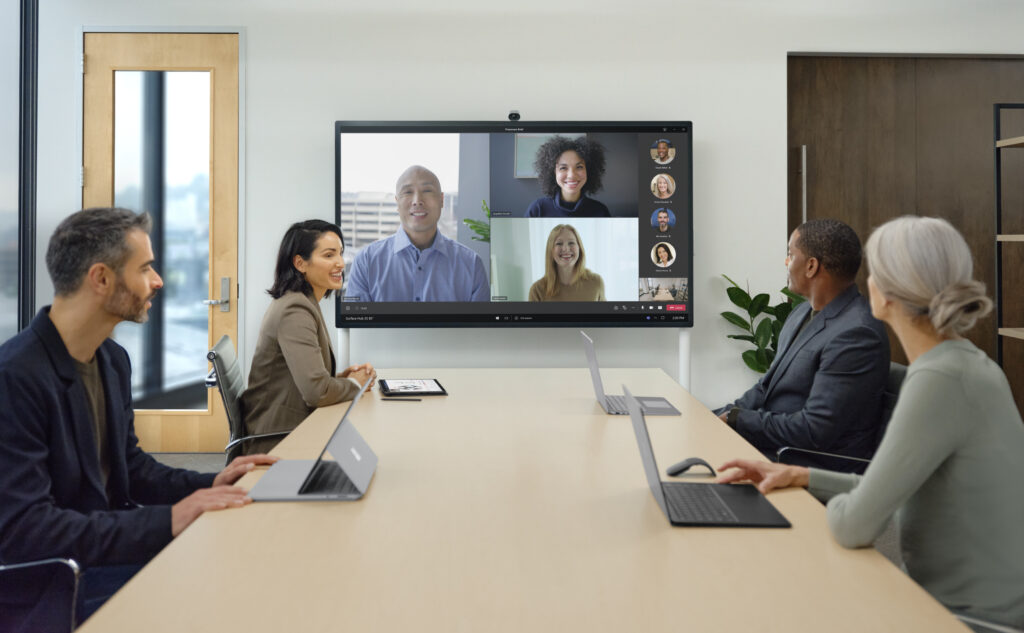Introduction
The world of work has changed so much in the last few years that the standard workplace technology we use daily is now very different. As hybrid and flexible work has become the norm in organisations all over the world, collaboration tools that connect office-based and home-based employees, such as Microsoft Teams Rooms are now critical to productivity and employee experience.
According to Unleash, more than half of employees have had occasions within the last six months where poorly performing IT has hindered their work. At the same time, Forbes found that employees felt they were working at just 60% of their potential productivity due to their current digital tools. So it’s clear that the importance of this technology, especially keeping it up-to-date and maximising its capabilities, can’t be overstated.
Although Microsoft Teams Rooms devices have been upgraded to Windows 11 automatically, with wider Windows 11 migration imminent, this blog explores why your meeting room kit shouldn’t be ignored.
The overlooked part of Windows 11 migrations
Most existing Teams Rooms devices in use today were deployed at the start of the hybrid work revolution, i.e. in 2020 and 2021. While these devices have now been made Windows 11 compatible, they will likely be showing their age, and therefore will need replacing soon in order to maximise Windows 11’s innovation and performance potential in the long term.
That’s why we recommend including Teams Rooms devices in the wider Windows 11 migration and hardware refresh strategy. This means you can benefit from:
- Future-proofing: investing in new devices now[1] ensures that the whole estate is fully up-to-date, and best-placed to take advantage of new Windows 11 features and enhancements in the future. According to Dell, 74% of business leaders say a two-year device refresh cycle boosts productivity across their organisations. Windows 11 is already packed with innovations like Copilot AI, and the capabilities of these will only accelerate in the years to come.
- Maximising buying power: by rolling everything into a single refresh and migration process, you can leverage greater buying power and get better deals on device packages.
- Incentivising office use: foster more in-person mentoring and camaraderie by ensuring seamless integration between in-office and remote workers. Employees can confidently use meeting rooms, making the office more attractive for teamwork. Organisations may also consider increasing collaborative spaces while reducing individual workstations, recognising that quality meeting areas are what employees value most and can’t easily replicate at home.
Making a full-scale refresh a practical reality
From making sure Teams Rooms devices are optimised for performance, to ensuring that employees have kit that is fully Windows 11-compatible, it’s clear that now is the time to pursue a comprehensive migration and device refresh process.
From an employee experience perspective, getting this migration and refresh right will:
- Support talent attraction and retention through seamless and innovative hybrid meeting room experiences that meet their expectations.
- Drive competitive advantages through a more productive and motivated workforce.
- Encourage greater in-person collaboration through meeting technology they want to utilise.
- Optimise meeting spaces to employee needs, replacing kit deployed in a rush post-pandemic.
It’s understandable that all of this sounds like a major – and expensive – undertaking, and as a result might sound daunting, even if it is such an important investment to make for the future. It’s for that reason that we at Visavvi have developed a range of services and support features, including extended licensing and financing packages. These enable organisations to spread the cost of the migration and refresh, and lighten the financial and operational burden of the change.
Many organisations have already completed successful Windows migration and device refreshes with Visavvi, taking advantage of:
- Device leasing: where Visavvi finances the hardware so that the cost can be spread over a set period and payment plan (normally three years), and can therefore be funded by operational rather than capital expenditure.
- Device-as-a-Service: device leasing spread over 36 monthly payments, after which devices can be returned or extended as required by the organisation. This service is integrated with support services including installation, delivery, asset management, repair and a built-in refresh cycle.
Both options allow for device returns or extensions based on organisational needs. However, we recommend the return option as it offers two key advantages: First, it ensures your estate remains up-to-date and capable of handling the latest platform releases. Second, it supports your environmental objectives by enabling the reuse and recycling of returned assets.
Perfecting the migration and refresh with Visavvi
Taking the leasing or Device-as-a-Service options helps with future-proofing hardware, as refresh cycles are naturally built in. This makes sure that employees and meeting rooms alike are always kitted out with the most up-to-date equipment, and consistently deliver the most intuitive and user-friendly experiences.
Partnering with Visavvi gives you the opportunity to right-size the migration and refresh to the specific needs of your organisation and workforce. Our free Pathfinder assessment, and more comprehensive Windows 11 Assessment, are the enablers of our bespoke approach. They help us clarify the current position of your IT estate, how a Windows 11 migration should be applied, and which of your devices should be refreshed and when. That way, you can make maximum improvements to employee experience, while simultaneously maximising cost efficiency.
Get in touch today.



